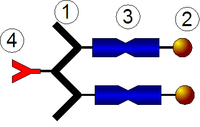
Photo from wikipedia
Fe/Fe3O4@r-GO composite nanocages with a hollow porous heterostructure, which look like “flower cluster,” are prepared by a mild, simple, and flexible method, followed by a thermal treatment. Metal-organic framework Prussian… Click to show full abstract
Fe/Fe3O4@r-GO composite nanocages with a hollow porous heterostructure, which look like “flower cluster,” are prepared by a mild, simple, and flexible method, followed by a thermal treatment. Metal-organic framework Prussian blue (PB), used as a precursor of Fe3O4, possesses a special hollow porous morphology, which is able to shorten transmission path and relives the mechanical stress during charge/discharge cycles. Verified by SEM and TEM characterizations, the Fe/Fe3O4 nanocage coated with uniform graphene sheets is achieved. Furthermore, XRD and XPS analysis combined with TEM results also prove that the composite is mainly composed of Fe, Fe3O4, and C. A series of electrochemical tests show that Fe/Fe3O4@r-GO composite electrodes exhibit a superior reversible capacity, rate capability, and cycling stability. The composite delivers a high reversible capability of 1200 mAh g−1 after 160 cycles at a current density of 100 mA g−1. Especially, when the current density is increased to 1000 mA g−1, the composite delivers a capacity of 455 mAh g−1. Even at a current density of 2000 mA g−1, a capacity of 355 mAh g−1 is retained. The outstanding electrochemical performances are mainly attributed to the integrity of hollow porous nanocube structure and doping of moderate graphene, which enables to promote the conductivity of electrode and build a continue network between Fe/Fe3O4 nanocubes to further accelerate ion/electron migration rate and relieve mechanical stress during cycles.
Journal Title: Journal of Solid State Electrochemistry
Year Published: 2020
Link to full text (if available)
Share on Social Media: Sign Up to like & get
recommendations!